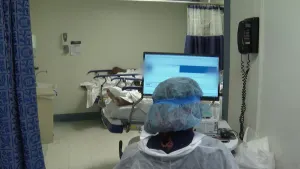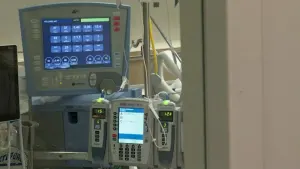US jobless claims drop to 787,000, but layoffs remain high
The number of Americans seeking unemployment benefits fell last week to 787,000, a sign that job losses may have eased slightly but are still running at historically high levels.
Share:
More Stories

Nobel in medicine goes to 2 scientists whose work enabled creation of mRNA vaccines against COVID-19
470ds ago1:25

Pharmacies say they have not received orders for newest COVID booster
475ds ago0:21

Biden administration announces $600M to produce COVID tests and will reopen website to order them
482ds ago0:41

Gov. Hochul: Updated COVID-19 vaccine to be available in NY in the coming days
489ds ago2:13

NYSDOH: COVID numbers up with new variant accounting for 17% of new cases
523ds ago2:30

NYSHD: Hospitalizations caused by COVID increase by 22% in a week
531ds ago
Nobel in medicine goes to 2 scientists whose work enabled creation of mRNA vaccines against COVID-19
470ds ago1:25

Pharmacies say they have not received orders for newest COVID booster
475ds ago0:21

Biden administration announces $600M to produce COVID tests and will reopen website to order them
482ds ago0:41

Gov. Hochul: Updated COVID-19 vaccine to be available in NY in the coming days
489ds ago2:13

NYSDOH: COVID numbers up with new variant accounting for 17% of new cases
523ds ago2:30

NYSHD: Hospitalizations caused by COVID increase by 22% in a week
531ds agoThe number of Americans seeking unemployment benefits fell last week to 787,000, a sign that job losses may have eased slightly but are still running at historically high levels.
With confirmed infections having neared 60,000 in the past week, the highest level since July, many consumers have been unable or reluctant to shop, travel, dine out or congregate in crowds - a trend that has led some employers to keep cutting jobs. Several states, such as Ohio and Idaho, are reporting a record number of hospitalizations from the virus.
Thursday’s report from the Labor Department said the number of people who are continuing to receive unemployment benefits tumbled by 1 million to 8.4 million. The decline shows that some of the unemployed are being recalled to their old jobs or are finding new ones. But it also indicates that many jobless Americans have used up their state unemployment aid - which typically expires after six months - and have transitioned to a federal extended benefits program that lasts an additional three months.
Many jobless recipients are now receiving only regular state unemployment payments because a federal weekly supplement of $300 has ended in nearly all states. And a $600-a-week federal benefit expired over the summer.
The still-elevated number of jobless claims underscores that a full recovery from the pandemic recession remains far off. Job growth has slowed for three straight months, leaving the economy still 10.7 million jobs short of its pre-pandemic level. The unemployment rate remains high at 7.9%.
And some major companies keep announcing layoffs. Aramark, a food services contractor that provides concessions at sports stadiums, said Wednesday that it would lay off 975 workers in Denver, most of whom worked at Coors Field, home of the Colorado Rockies. The company is also cutting 550 jobs in Kansas City. Most major league baseball games this season were played with limited or no crowds, thereby reducing the need for concession workers
Amtrak said at a congressional hearing Wednesday that it would have to cut 2,400 jobs unless Congress approves emergency aid as part of another stimulus bill.
Yet negotiations in Congress over another round of financial aid have largely stalled, with little prospect for a deal before Election Day. Democratic House Speaker Nancy Pelosi and Treasury Secretary Steven Mnuchin are continuing to negotiate. But Republican Senate Majority Leader Mitch McConnell has warned the White House against agreeing to a large package that would be opposed by most Senate Republicans
Unless Congress can agree on a significant new rescue aid program, most economists expect growth to slow in the final three months of the year from a rapid rebound in the July-September quarter. That would mean a more prolonged recovery of the jobs and output that the economy lost to the coronavirus.
Congress’ failure to extend aid would also deepen the hardship for many of the jobless, who are struggling to pay bills with unemployment checks that, on average, replace just one-third of their prior earnings. Nearly one in six renters -- 11.8 million people -- are behind on their rent payments, according to an analysis of Census data by the Center on Budget and Policy Priorities.
The number of people whose state benefits have expired and are now receiving aid for an additional 13 weeks from a federal extended benefit program rose last week by 509,000 to 3.3 million, the government said.
An additional 345,000 people applied for jobless aid under a separate program that made the self-employed, contractors and gig workers eligible for unemployment benefits for the first time. Those figures aren’t adjusted for seasonal trends, so they are reported separately.
Both the extended aid and the jobless aid for contractors and gig workers will expire by year’s end. Millions of unemployed people would then be left without any benefits at all. An exception is in states with particularly high unemployment, where laid-off workers can receive 13 more weeks of state aid.
(By Christopher Rugaber, AP Writer)
More from News 12
1:27

Suffolk officials: At least two dozen people displaced after fire tears through Central Islip apartment
1:34

More windy weather ahead before some relief by Friday
1:47

Parents challenge Long Beach School District over potential elementary school closure
0:32

West Babylon Schools considers closing Forest Avenue Elementary School
2:08

Gov. Hochul focuses on making child care affordable in State of the State address
1:59
